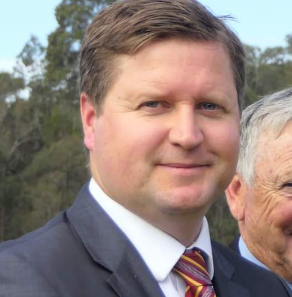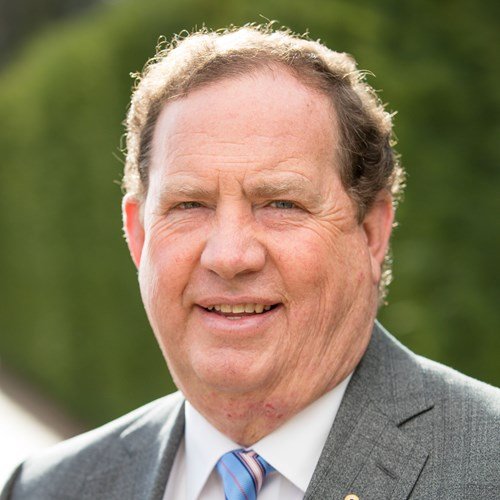
ABOUT
Australian Bravery Association
Vice-Patrons
Darrell Tree CV
On 14 August 1988 Mr Darrell Tree, accompanied by his nephew, went to assist a crane-operator in removing wooden telephone poles along the edge of the road running beside his property near Talia. The driver had his 3 year old son on the crane with him. When Mr Tree went to put a chain around a pole he saw sparks jumping from the crane's tyres and that the jib of the crane was in contact with the powerline. The driver jumped clear and went to remove his son, who at that time was in a boxed section and not coming into contact with electricity.
Sparks were arcing beneath the crane to the ground and twice Mr Tree stopped the driver from going to the truck. He warned him not to touch the boy as he knew that the crane was alive with electricity and that he would be electrocuted. He went to get a rope and turning round he realised that the driver must have attempted to rescue his son, as he had electricity arcing through his body and was being electrocuted. Mr Tree pushed him clear and fell to the ground unconscious having himself been electrocuted. Regaining consciousness Mr Tree saw the boy standing between the tyre and the mudguard with electricity entering his head near his right ear, passing through his body and also entering near his left elbow. Knowing that the boy was about to be fatally electrocuted he pulled him clear and again lost consciousness having been electrocuted once more. When he regained consciousness on the second occasion he found that neither the driver nor his son was breathing.
On his own, as he had sent his nephew for the ambulance, he gave mouth the mouth resuscitation to them both. The boy responded, but in spite of Mr Tree's further attempts to give the father cardio-pulmonary resuscitation, he died before medical assistance arrived. Mr Tree comforted the boy and drove him to meet the ambulance. He then followed the ambulance to the hospital at Elleston and was later flown to Adelaide for treatment. In saving the boy's life Mr Tree had 19 stiches inserted in his left arm, 37 stitches to his back, 5 stitches on his right foot and 5 stitches on his left foot. One toe on his left foot was amputated and he received burns to his back.
By his actions Mr Tree displayed most conspicuous courage.

Victor Boscoe CV
On the morning of 13 September 1993 in the northern suburbs of Brisbane Mr Victor Boscoe witnessed an armed hold-up and repeatedly placed his life in danger by pursuing two armed men fleeing from the scene with the proceeds of the robbery.
Although he had heard a shot fired, Mr Boscoe followed the offenders to the car park and identified their 'getaway' vehicle. He pursued the vehicle in his own car through difficult traffic conditions and maintained visual contact. The offenders changed cars, observing Mr Boscoe in the process. Mr Boscoe continued his pursuit at high speed.
Unable to elude their pursuer, the offenders stopped their car and threatened Mr Boscoe with a shotgun and a handgun. Mr Boscoe immediately rammed their car. Several shots were fired at him.
Despite his wounds from the shotgun and glass and metal fragments Mr Boscoe was able to manoeuvre his vehicle free and to continue his pursuit of the offenders, through another change of vehicle, until forced to stop because of the damage caused to his car by the act of ramming.
Mr Boscoe suffered injuries to his shoulder, arm and hand.
As a result of his courageous efforts and presence of mind Mr Boscoe was able to provide Police with a useful description of the armed robbers, which assisted in the subsequent conviction of the principal offender.
By his actions Mr Boscoe displayed most conspicuous courage.


Richard Joyes CV
Richard Joyes was awarded the Cross of Valour for his efforts to rescue those in the Sari Club on 12 October 2002 during the Bali bombing. He, along with others, ran towards the bombsite and fought his way through intense flames to help rescue the wounded and carry them to safety.
He is the fifth recipient of the Cross of Valour since its inception as part of the Australian honours system in 1975.

Doug Baird OAM
(father of Corporal Cameron Baird VC, MG)
Doug Baird is a former Australian rules footballer who played with Carlton in the Victorian Football League. His son Corporal Cameron Baird VC, MG was an Australian soldier and posthumous recipient of the Victoria Cross for Australia.
Cameron Baird was born in Burnie, Tasmania in 1981, whilst his father was coaching the Cooee Football Club. Along with his family, he moved to Victoria in 1984 and grew up in Gladstone Park, a northwestern suburb of Melbourne. Cameron was educated at Gladstone Park Secondary College.
Cameron was a talented junior Australian rules footballer who played with the Calder Cannons and one game for Geelong in the Victorian Football League. He nominated for the 1999 AFL draft, but suffered a shoulder injury late in the 1999 season, and was not selected by any AFL teams.
Cameron joined the Australian Regular Army in January 2000 and was posted to 4th Battalion (Commando), Royal Australian Regiment (now 2nd Commando Regiment). He served in East Timor and Iraq and was deployed four times to Afghanistan. Cameron was awarded the Medal of Gallantry in 2007 on his second operational tour.
Cameron was on his fourth tour of Afghanistan in 2013 when he was involved in the action for which he was awarded the Victoria Cross. On 22 June, as team commander, he participated in an assault on the Taliban-held village of Ghawchak in Uruzgan province. Shortly after the helicopter insertion, Cameron led his team in silencing a number of enemy positions while under heavy small-arms fire. He then went to the aid of another team whose commander had been seriously wounded. With selfless disregard for his own safety, he drew the fire from an enemy machine-gun position, “the bullets hitting the ground around him”. He managed to suppress the enemy fire, allowing his team to regain the initiative.
Once in the enemy compound, Cameron forced his way into hostile buildings amid intense small-arms fire. He charged the enemy’s position three times to draw fire away from his team. On the third occasion, Corporal Baird’s actions “enabled the enemy to be neutralised and kept his team safe, but ultimately cost him his life.
Today Doug Baird continues to honour Cameron's memory and service.
Doug was awarded the Medal of the Order of Australia in the 2019 Queen’s Birthday Honours List for service to veterans and their families.
Richard Rolfe AM
Richard Rolfe AM has been a member of the National Australia Day Council (NADC) Board since May 2016 and also serves as the Chair of the NADC Audit & Assurance Committee. As the Director of the Audi Centre in Canberra, Richard has built a successful career in the motor industry over the past 34 years during which he has developed a reputation for his acute business acumen. Both within the motor industry and the broader Canberra community, Richard is recognised for his expertise in developing business strategy, leadership, event management, marketing and communications and business planning. In addition to his business pursuits, Richard also has a strong involvement in the Canberra community. In 2009, Richard was awarded the Order of Australia Medal (OAM) for service to the community of Canberra through philanthropic support for sporting, service and charitable organisations. In 2017, Richard was elevated from the OAM to a Member of the Order of Australia (AM) for significant service to the community of the Australian Capital Territory through philanthropic support of medical, cultural and social welfare organisations. Currently, Richard is Patron of the Heart Foundation (ACT), Vice-Patron of the Cross of Valour Association, a major supporter of Lifeline, the Heart Foundation, Home in Queanbeyan and the founding member of the AUDI Foundation. Richard holds a Bachelor of Economics from ANU.
Well known in the community for working with charitable groups for many years, Richard’s wife, Debbie Rolfe AM is Chair of the Canberra Hospital Foundation, Ambassador for the Early Morning Centre in Braddon, as well as being a strong supporter of Home in Queanbeyan. This has been achieved while playing a significant full-time role as a Partner at Maliganis Edwards Johnson a major local law firm. Debbie was awarded the Medal of the Order of Australia in 2017.
Together the Rolfe’s have focused on physical and mental health, but they also provide enormous support to the Canberra Capitals, Canberra Raiders and Canberra Cavalry, and a number of Olympic and Paralympic athletes, as well as making significant contributions to the public collections of the Australian War Memorial and the Royal Australian Mint.





